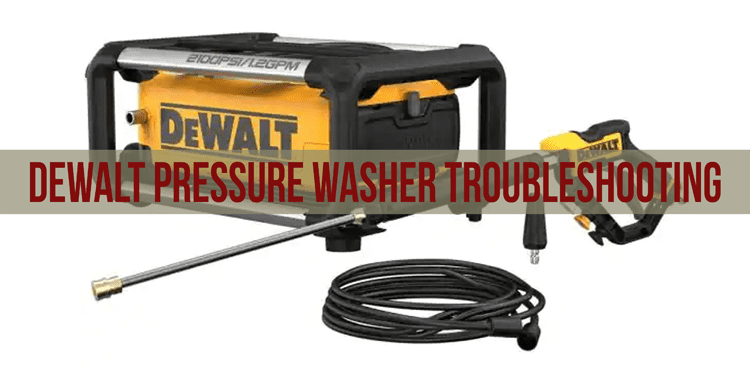The majority of malfunctions of pressure washer could be diagnosed and repaired by the owner without difficulties. The table includes the most common faults and repair methods.
DeWalt 3400 PSI, PCV2250 pressure washer troubleshooting
| PROBLEM | CAUSE | CORRECTION |
|---|---|---|
| No or low pressure (initial use). | Choke in the “CHOKE” Position. | Move choke to the “NO CHOKE” position. |
| High pressure hose is too long. | Use high pressure hose under 100 feet (30m). | |
| Will not draw chemicals. | Spray wand not in low pressure. | See How to Use Spray Wand section. |
| Chemical filter is clogged. | Clean filter. | |
| Chemical screen not in cleaning solution. | Make sure end of chemical hose is fully submerged into cleaning solution. | |
| Chemical is too thick. | Dilute chemical. Chemical should be the same consistency as water. | |
| Pressure hose is too long. | Lengthen water supply hose instead of high pressure hose. | |
| Chemical build up in chemical injector. | ||
| No or low pressure (after period of normal use). | Worn seal or packing. | |
| Worn or obstructed valves. | ||
| Worn unloader piston. | Have parts cleaned or replaced by Authorized Service Center. | |
| Water leaking at gun/spray wand connection. | Work or broken o-ring. | Check and Replace |
| Loose Hose Connection. | Tighten. | |
| Water leaking at pump. | Loose Connections. | Tighten. |
| Piston packings worn. | ||
| Work or broken o-rings. | ||
| Pump head or tubes damaged from freezing. | Have parts cleaned or replaced by Authorized Service Center. | |
| Pump pulsates. | Nozzle Obstructed. | See Nozzle Cleaning paragraph in MAINTENANCE section for the correct procedure. |
DeWalt DPD3100 pressure washer troubleshooting
| CODE | POSSIBLE CAUSE | POSSIBLE SOLUTION |
|---|---|---|
| 1 | No fuel. | Add fuel. |
| 2 | Low oil. | Add required amount of oil. |
| 3 | Pressure builds up after two pulls on the recoil starter or after initial use. | Squeeze gun trigger to relieve pressure. |
| 4 | Choke lever in the NO CHOKE position. | Move choke to the CHOKE position. |
| 5 | Spark plug wire not attached. | Attach spark plug wire. |
| 6 | Engine ON/OFF switch in OFF position. | Place engine ON/OFF switch in ON position. |
| 7 | Choke lever in the CHOKE position on a hot engine or an engine that has been exposed to thermal heat for a long period of time. | Move choke to the NO CHOKE position. |
| 8 | Fuel valve closed. | Move the fuel valve lever to the OPEN position. |
| 9 | Spray wand not in high pressure. | See Spray Wand Nozzles under Operation. |
| 10 | Low water supply. | Water supply must be at least 5 GPM @ 20 PSI (138 kPa). |
| 11 | Leak at high-pressure hose fitting. | Repair leak. Apply sealant tape if necessary. |
| 12 | Nozzle obstructed. | See Nozzle Cleaning under Maintenance. |
| 13 | Water filter screen clogged. | Remove and clean filter. |
| 14 | Air in hose. | Turn off the engine, then the water source. Disconnect the water source from the pump inlet and turn the water source on to remove all air from the hose. When there is a steady stream of water present, turn water source off. Reconnect water source to pump inlet and turn on water source. Squeeze trigger to remove remaining air. |
| 15 | Choke lever in the CHOKE position. | Move choke to the NO CHOKE position. |
| 16 | High-pressure hose is too long. | Use high-pressure hose under 100 feet (30.48 m). Lengthen water supply hose instead of high-pressure hose. |
| 17 | Spray wand not in low pressure. | See Spray Wand Nozzles under Operation. |
| 18 | Chemical filter clogged. | Clean filter. |
| 19 | Chemical screen not in cleaning solution. | Make sure end of chemical hose is fully submerged into cleaning solution. |
| 20 | Chemical too thick. | Dilute chemical. Chemical should be the same consistency as water. |
| 21 | Worn seal or packing. | Have parts cleaned or replaced by authorized service center. |
| 22 | Chemical build up in chemical injector. | Have replaced by an authorized service center. |
| 23 | Worn or obstructed valves. | Have replaced by authorized service center. |
| 24 | Worn unloader piston. | |
| 25 | Worn or broken o-ring. | Check and replace. |
| 26 | Loose hose connection. | Tighten. |
| 27 | Piston packings worn. | Have replaced by authorized service center. |
| 28 | Pump head or tubes damaged from freezing. | |
| 29 | Air filter filled with oil. | Clean air filter element. Refer to engine instruction manual for correct procedure. |
